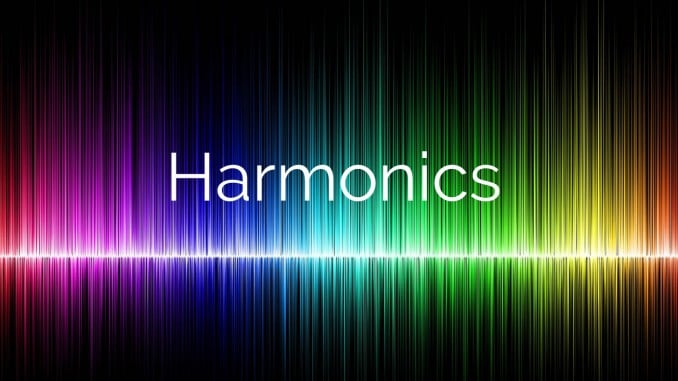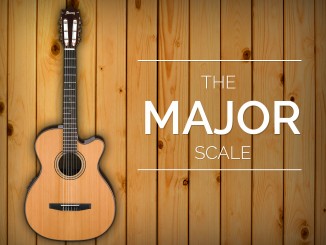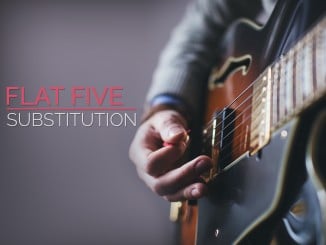
Harmonics are played every time you pluck a note. Most of the time, however, you do not hear them. What you hear is the fundamental (sometimes called the first harmonic). The fundamental is the loudest sound produced, but it is accompanied by several harmonics. “Playing harmonics” on guitar is actually playing “artificial harmonics.” Basically, it is a way of eliminating the fundamental and the other overtones. It produces a nice effect that many guitarists like to use. There are several ways to play these.
Open-String Harmonics
Open-string harmonics are sometimes referred to as natural harmonics. To play open-string harmonics, you can place your finger lightly on the string in the places shown in the diagram below. Do not press the string down. It should not touch anything but your finger. By doing this, you will play the note shown in the diagram over the given area.

Fretted Harmonics
Playing fretted harmonics can be hard at times. This requires the fretting of a note, plus a “soft touch” on a string which is exactly 12 frets above the note you are fretting. In addition to this you must still pluck the string. To do all three of these tasks at once, you must combine the tasks of the “soft touch” and the plucking of the string. There are 2 techniques of doing this.
Technique 1: Artificial Harmonics
Although all harmonics that you play are actually artificial harmonics, this technique is commonly referred to as playing an artificial harmonic. This technique requires that you “soft touch” with your index finger and then pluck with your pinky finger or a pick held in the other fingers. The other technique is playing a pinched harmonic which is more difficult to learn but will allow you to play fretted harmonics more quickly once it is mastered.
Technique 2: Pinched Harmonics
This is a difficult technique to master. Consistent playing of pinched harmonics require that you use a modified picking technique along with a steady and accurate picking hand. The first thing that you must master is how to hold the pick and pluck the string. You hold the pick by having the pick barely clear the bottom of your thumb. The key is to pluck the string with the pick but have the thumb immediately hit it to produce the harmonic. This pick and thumb should hit the string almost simultaneously.
You must also know where to pluck the string. If you do not hit the “sweet spot” on the string it will sound like a muffled note. The ideal place to pluck depends on where your thumb produces the harmonic. Your thumb should hit the string half way between the bridge and the the fret that you are playing on. So when you play on different frets, you must also pluck in different places. This makes it a little harder to play.
Note: There are other sweet spots as well. The sweet spots are proportional to the length of the string. When you play open-string harmonics, there are several places that produce harmonics. These are the “sweet spots” for a full length string (open string). When you fret a note, all the “sweet spots” stay in proportion to the string length, which is the length from the fret you are playing to the bridge. Therefore, several “sweet spots” exist for both open-string and fretted harmonics. The one thing to remember is that they are not all one octave higher so hitting alternate “sweet spots” will play a different note.
The Physics of Harmonics
Did you ever wonder why a harmonic is produced? It’s quite simple actually. It is a matter of string length. When you use your finger to produce a harmonic, you modify how the string vibrates. When playing open string harmonics, you split the string into halves, thirds, fourths, fifths, and sixths. So playing the harmonics at the 12th fret split the string in half. Playing at the 7th or 19th fret split the string into thirds, and so on. You will also notice that playing harmonics at the 7th or 19th fret are exactly the same notes. You can also split the guitar into fourths at the 5th fret or the 24th fret (or where the 24th fret would be if you don’t have that many frets). Once again, harmonics at the 5th and 24th frets produce the exact same notes. Notice that the 12th fret isn’t included because that splits the string into halves (larger subsections of the string).
| Normal Note’s Waveform | |
| Same note one octave higher (harmonic dividing by one-half) |
|
| Harmonic dividing wavelength by one-third |
So how does it work? Your finger acts as a pivot point for the string by forcing the string to vibrate in halves, thirds, fourths, etc. This cuts the wavelength in half, thirds, fourths, etc. Wavelength determines what the frequency of a note is, and frequency determines what note you are playing. Did you ever hear someone say to tune to A at 440? The 440 represents the frequency of the A note at the 1st string at the 5th fret. If you double that frequency, you will play an A that is an octave higher. This also cuts the wavelength in half. You might be able to see the relationship between frequency and wavelength. Frequency is inversely proportional to wavelength. This basically means that wavelength = 1 / frequency. In other words cutting wavelength in half with double the frequency, and cutting the wavelength into 1/3 will triple the frequency.
So why do all my strings make different sounds even though they are the same length? This occurs due to the tension on the string. Basically the tension of the string modifies how the string vibrates so that it has a different frequency. When you adjust the tension, you also change the diameter of the string. Stretching or tightening the string makes the diameter smaller.





nice. helped me understand why?
Thank you for the kind words.
this will help me learn By Myself from linkin park. i hope you have an excellent dinner tonight, good sir
Thank you. I’m glad it will help. Also, I had a great dinner. ha ha.